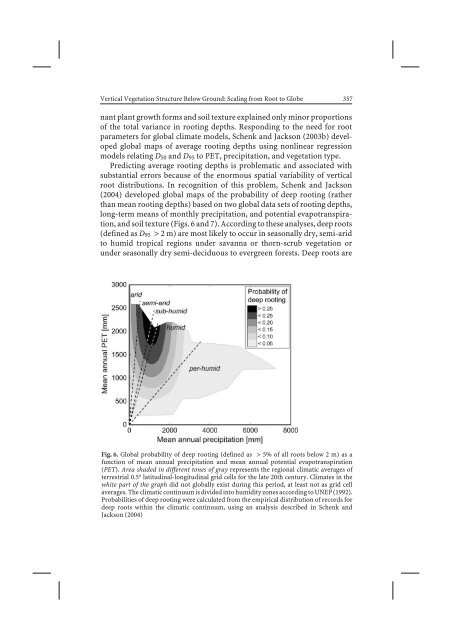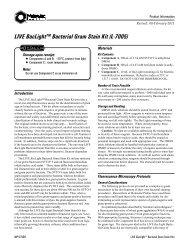Vertical Vegetation Structure Below Ground: Scaling from Root
Vertical Vegetation Structure Below Ground: Scaling from Root
Vertical Vegetation Structure Below Ground: Scaling from Root
You also want an ePaper? Increase the reach of your titles
YUMPU automatically turns print PDFs into web optimized ePapers that Google loves.
<strong>Vertical</strong> <strong>Vegetation</strong> <strong>Structure</strong> <strong>Below</strong> <strong>Ground</strong>: <strong>Scaling</strong> <strong>from</strong> <strong>Root</strong> to Globe 357nant plant growth forms and soil texture explained only minor proportionsof the total variance in rooting depths. Responding to the need for rootparameters for global climate models,Schenk and Jackson (2003b) developedglobal maps of average rooting depths using nonlinear regressionmodels relating D 50 and D 95 to PET, precipitation, and vegetation type.Predicting average rooting depths is problematic and associated withsubstantial errors because of the enormous spatial variability of verticalroot distributions. In recognition of this problem,Schenk and Jackson(2004) developed global maps of the probability of deep rooting (ratherthan mean rooting depths) based on two global data sets of rooting depths,long-term means of monthly precipitation,and potential evapotranspiration,andsoil texture (Figs. 6 and 7). According to these analyses,deep roots(defined as D 95 > 2 m) are most likely to occur in seasonally dry,semi-aridto humid tropical regions under savanna or thorn-scrub vegetation orunder seasonally dry semi-deciduous to evergreen forests. Deep roots areFig.6.Global probability of deep rooting (defined as > 5% of all roots below 2 m) as afunction of mean annual precipitation and mean annual potential evapotranspiration(PET). Area shaded in different tones of gray represents the regional climatic averages ofterrestrial 0.5° latitudinal-longitudinal grid cells for the late 20th century. Climates in thewhite part of the graph did not globally exist during this period,at least not as grid cellaverages. The climatic continuum is divided into humidity zones according to UNEP (1992).Probabilities of deep rooting were calculated <strong>from</strong> the empirical distribution of records fordeep roots within the climatic continuum,using an analysis described in Schenk andJackson (2004)
















